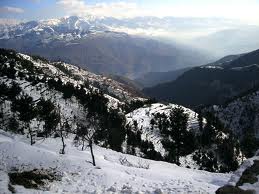Ābṭābād [aːbʈaːˈbaːd̪])
is a city located in the Hazara region of the Khyber Pakhtunkhwa province, in Pakistan. The city is situated in the Orash Valley, 50 kilometres (31 mi) northeast of the capital Islamabad and 150 kilometres (93 mi) east of Peshawar at an altitude of 1,260 metres (4,134 ft) and is the capital of the Abbottabad District. The city is well-known throughout Pakistan for its pleasant weather, high-standard educational institutions and military establishments.[2]
History
Commissioner of the Hazara district from 1849 until April 1853. Major Abbott is noted for having written a poem titled "Abbottabad", before he went back to Britain, in which he wrote of his fondness for the town and his sadness at having to leave it. In the early 20th century, Abbottabad became an important military cantonment and sanatorium, serving as the headquarters of a brigade in the Second Division of the Northern Army Corps.[3] The garrison consisted of four battalions of native infantry (Gurkhas and Frontier Force) and four native mountain batteries.[4]
In 1901, the population of the town and cantonment was 7,764[3] and the income averaged around Rs. 14,900. This increased to Rs. 22,300 in 1903, chiefly derived from octroi. During this time chief public institutions were built such as the Albert Victor unaided Anglo-Vernacular High School, the Municipal Anglo-Vernacular High School and the Government dispensary.[4] In 1911, the population had risen to 11,506 and the town also contained four battalions of Gurkhas.[5]
In June 1948, the British Red Cross opened a hospital in Abbottabad to deal with thousands of patients who were being brought in from the Kashmir fighting areas.[6] On 8 October 2005 Abbottabad was devastated by the Kashmir earthquake. Although most of Abbottabad survived, many old buildings were destroyed or damaged.[7]
On 2 May 2011, Abbottabad gained worldwide attention when U.S. President Barack Obama announced that Osama bin Laden had been killed in his compound in the city.[8][9]
Languages
According to the 1998 Census of the 881,000 who resided in the Abbottabad District, Hindko was spoken by 94.26% of the population, followed by Potohari at 2.30%, Pashto at 2.22% and Urdu at 1.05%.[11] Although the first language of most people in the district is Hindko, Urdu is understood and spoken fluently by majority of the residents and commonly used in markets, offices and formal functions. English is widely used in business and education.
is a city located in the Hazara region of the Khyber Pakhtunkhwa province, in Pakistan. The city is situated in the Orash Valley, 50 kilometres (31 mi) northeast of the capital Islamabad and 150 kilometres (93 mi) east of Peshawar at an altitude of 1,260 metres (4,134 ft) and is the capital of the Abbottabad District. The city is well-known throughout Pakistan for its pleasant weather, high-standard educational institutions and military establishments.[2]
History
Commissioner of the Hazara district from 1849 until April 1853. Major Abbott is noted for having written a poem titled "Abbottabad", before he went back to Britain, in which he wrote of his fondness for the town and his sadness at having to leave it. In the early 20th century, Abbottabad became an important military cantonment and sanatorium, serving as the headquarters of a brigade in the Second Division of the Northern Army Corps.[3] The garrison consisted of four battalions of native infantry (Gurkhas and Frontier Force) and four native mountain batteries.[4]
In 1901, the population of the town and cantonment was 7,764[3] and the income averaged around Rs. 14,900. This increased to Rs. 22,300 in 1903, chiefly derived from octroi. During this time chief public institutions were built such as the Albert Victor unaided Anglo-Vernacular High School, the Municipal Anglo-Vernacular High School and the Government dispensary.[4] In 1911, the population had risen to 11,506 and the town also contained four battalions of Gurkhas.[5]
In June 1948, the British Red Cross opened a hospital in Abbottabad to deal with thousands of patients who were being brought in from the Kashmir fighting areas.[6] On 8 October 2005 Abbottabad was devastated by the Kashmir earthquake. Although most of Abbottabad survived, many old buildings were destroyed or damaged.[7]
On 2 May 2011, Abbottabad gained worldwide attention when U.S. President Barack Obama announced that Osama bin Laden had been killed in his compound in the city.[8][9]
Languages
According to the 1998 Census of the 881,000 who resided in the Abbottabad District, Hindko was spoken by 94.26% of the population, followed by Potohari at 2.30%, Pashto at 2.22% and Urdu at 1.05%.[11] Although the first language of most people in the district is Hindko, Urdu is understood and spoken fluently by majority of the residents and commonly used in markets, offices and formal functions. English is widely used in business and education.















